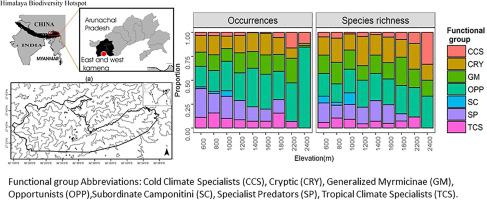Journal of Asia-Pacific Entomology ( IF 1.1 ) Pub Date : 2021-08-14 , DOI: 10.1016/j.aspen.2021.08.009 Aniruddha Marathe 1, 2 , Kartik Shanker 2 , Jagdish Krishnaswamy 1 , Dharma Rajan Priyadarsanan 1

|
Elevational gradients in mountains show rapid changes in environmental conditions across a small geographic extent. This results in habitat specialization in animal communities which results in changes in species composition across space. We explore changes in species and functional group composition of ants using the first ever data on the distribution of ants across an elevational gradient in the Eastern Himalaya. Ants were sampled from 600 to 2400 m elevations at 200 m intervals using Winklers and pitfall traps. The sampling yielded 166 species of ants from 10,560 individuals, which were then classified into functional groups. We used redundancy analysis to test the effects of environmental factors (temperature, leaflitter volume, understory vegetation) and spatial predictors on species as well as functional group composition of communities at different elevations. Our results show that species diversity within all functional groups decreases towards higher elevations. The functional group composition of ant communities shows a gradient from high evenness at low elevations to being dominated by opportunist species at higher elevations. Redundancy analyses shows that most of the variation in species as well as functional group composition is driven by spatially structured environmental variation. This is most likely due to the high correlation between temperature and elevation. In summary, the changes in species as well as functional group composition are likely driven by a gradient in climate across the elevation gradient.
中文翻译:

喜马拉雅东部海拔梯度上蚂蚁群落的种类和功能群组成
山区的海拔梯度显示了小地理范围内环境条件的快速变化。这导致动物群落的栖息地专业化,从而导致整个空间的物种组成发生变化。我们使用有关蚂蚁在东喜马拉雅山脉海拔梯度分布的首个数据来探索蚂蚁的物种和功能组组成的变化。使用 Winklers 和陷阱陷阱以 200 m 的间隔从 600 到 2400 m 的海拔对蚂蚁进行采样。采样从 10,560 个人中产生了 166 种蚂蚁,然后将其分类为功能组。我们使用冗余分析来测试环境因素(温度、落叶量、林下植被)和物种的空间预测因子以及不同海拔群落的功能群组成。我们的结果表明,所有功能组内的物种多样性随着海拔升高而降低。蚂蚁群落的功能群组成呈现出从低海拔的高均匀度到高海拔的机会主义物种占主导地位的梯度。冗余分析表明,物种和功能组组成的大部分变化是由空间结构的环境变化驱动的。这很可能是由于温度和海拔高度相关。总之,物种和功能群组成的变化可能是由海拔梯度上的气候梯度驱动的。我们的结果表明,所有功能组内的物种多样性随着海拔升高而降低。蚂蚁群落的功能群组成呈现出从低海拔的高均匀度到高海拔的机会主义物种占主导地位的梯度。冗余分析表明,物种和功能组组成的大部分变化是由空间结构的环境变化驱动的。这很可能是由于温度和海拔高度相关。总之,物种和功能群组成的变化可能是由海拔梯度上的气候梯度驱动的。我们的结果表明,所有功能组内的物种多样性随着海拔升高而降低。蚂蚁群落的功能群组成呈现出从低海拔的高均匀度到高海拔的机会主义物种占主导地位的梯度。冗余分析表明,物种和功能组组成的大部分变化是由空间结构的环境变化驱动的。这很可能是由于温度和海拔高度相关。总之,物种和功能群组成的变化可能是由海拔梯度上的气候梯度驱动的。蚂蚁群落的功能群组成呈现出从低海拔的高均匀度到高海拔的机会主义物种占主导地位的梯度。冗余分析表明,物种和功能组组成的大部分变化是由空间结构的环境变化驱动的。这很可能是由于温度和海拔高度相关。总之,物种和功能群组成的变化可能是由海拔梯度上的气候梯度驱动的。蚂蚁群落的功能群组成呈现出从低海拔的高均匀度到高海拔的机会主义物种占主导地位的梯度。冗余分析表明,物种和功能组组成的大部分变化是由空间结构的环境变化驱动的。这很可能是由于温度和海拔高度相关。总之,物种和功能群组成的变化可能是由海拔梯度上的气候梯度驱动的。这很可能是由于温度和海拔高度相关。总之,物种和功能群组成的变化可能是由海拔梯度上的气候梯度驱动的。这很可能是由于温度和海拔高度相关。总之,物种和功能群组成的变化可能是由海拔梯度上的气候梯度驱动的。










































 京公网安备 11010802027423号
京公网安备 11010802027423号